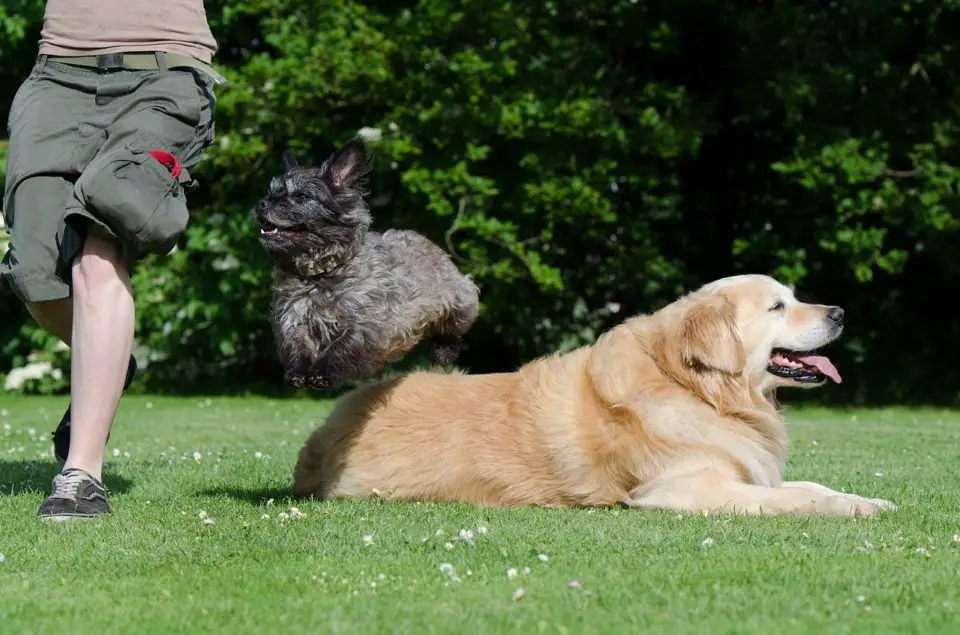I have an extensive background in the pet world, from three years of working at a holistic pet store, to pet-sitting, training, and I’m also the vice president of a pet nonprofit organization called Their Voice.
Needless to say, I’ve met many a pooch, and I have helped many people train their pets.
I’m Leah Spaulding, and I’m here to teach you four easy tricks you can teach your dog in an easy step-by-step guide!
These tricks are the essentials you should teach your dog–the basics that every dog should know. I’ve also included another easy trick just for fun!
If you are a beginner, you’re in the right place. First, I’ll go over what you’ll need before you get started, and then I will provide a thorough walkthrough some easy-to-teach tricks for your furry friend.
I’ll also include some useful tips on training and where you can find more on training your dog!
The Necessities for Dog Training
Let’s start out by going over the things you’ll need before beginning any training. You’ll want to prepare a few things to ensure your pup’s success.
You’ll need some training-treats, and a pouch to carry them in.
It’s important to have them with you at all times during training so you can reinforce the behavior you are looking for. It’s also crucial to find an appropriate space to train.
Get Training Treats
For positive reinforcement, get a low-calorie training treat like Cloud Star Tricky Trainers Chewy Grain Free Treats or Fruitables Crunchy Apple Bacon Biscuit Training Treats.
As an alternative, if your dog is food-motivated enough, you can use their food kibble.
Get a Treat Pouch
 Having a pouch or container with you so you can dispense training treats as soon as you see the behavior you are looking for is the best way to quickly train your dog.
Having a pouch or container with you so you can dispense training treats as soon as you see the behavior you are looking for is the best way to quickly train your dog.
Positive reinforcement is all about timing–so it’s essential to optimise by having treats with you.
You can get a training treat pouch like this, or you can keep a ziplock bag in your pocket or a fanny pack for easy access.
Now that you have treats and a treat pouch, it’s time to get training!
Find an Appropriate Space
Find a location in your home or outside that is free from distractions. Distractions to avoid include other pets, children playing, people eating, and the television playing in the background.
Using an appropriate space will help you to maximize efficiency in training. I usually recommend a living room with any furniture pushed to the sides of the room.
Your dog should have plenty of room to stretch out and feel comfortable.
Four Easy Dog Tricks for Beginners
#1: Teaching Your Dog How to Sit
Personally, I recommend the “luring” technique of training a dog to sit.
This technique involves using a treat to guide your dog into the sitting position.
It can be taught in three easy steps:
1. Use the Hand Signal
Hold a training treat above your pup’s head by its nose and move your hand in a slow, upward motion.
Your dog will lean back to follow your hand with their eyes.
2. Reward Your Dog for Sitting
 With some patience, the natural progression of your dog following the treat with their eyes will eventually lead them to sitting down.
With some patience, the natural progression of your dog following the treat with their eyes will eventually lead them to sitting down.
As soon as your dog sits, immediately reward their behavior with a training treat as you say the command, “sit.”
3. Practice Makes Perfect
Practice steps one and two multiple times per day. Your dog should gradually take less and less time to sit down as you use the same command and hand signal.
Once you and your dog have practiced this enough, your dog will be able to sit with just the command.
A Helpful Tip
Never force your dog’s bottom down on the ground.
It could hurt them or give them a negative association to an otherwise positive learning experience.
Quick Recap
To recap, lure your dog into the sitting position by using a treat in your hand.
Once your dog sits, immediately say the command and reward their behavior with a training treat.
Repeat those steps until your dog sits as soon as you use the command.
#2: Teaching Your Dog How to Stay
Teaching your dog how to stay is one of the most useful commands you can teach your dog–to manage your dog’s impulsive tendencies and ensure their safety.
Thankfully, stay is an easy four-step process. As a prerequisite, your dog should know sit first.
1. Teach Your Dog the Release Word
 Your dog will have to learn the “release word” before teaching your dog how to stay, don’t don’t fret–this is an easy one!
Your dog will have to learn the “release word” before teaching your dog how to stay, don’t don’t fret–this is an easy one!
Simply have your dog sit, toss a treat in front of them on the floor, and say the release word of your choice (usually “okay” or “release”–just remember to be consistent).
Practice this for a few days.
2. Take a Step Back
After asking your furry friend to sit, take a step back. If your dog remains in the sitting position after you’ve moved, say “stay” and reward your dog with a treat.
Use a hand signal with your palm like a stop sign. If your dog gets up when you take a step back, just try again.
3. Continue Adding Distance
After your dog is comfortable staying with you taking a step back, take another step back.
Continue rewarding them with training treats and using the command.
4. Practice Until You can Leave the Room with Dog Staying
Repeat steps two and three until you can take so many steps back you can leave the room and your dog will remain where they were.
A Helpful Tip
Since my dog knows “stay,” I keep the front door open as I’m carrying in groceries without worrying my dog will run out. I also know I can tell him to stay in the back seat when I’m driving.
Teaching your dog how to stay will help to ensure your dog’s safety in the case of danger and their attention in the case of distractions nearby.
Make teaching your dog how to stay a priority, and you will be grateful you did.
Quick Recap
To summarize, teaching stay can be taught in three simple steps.
First, have your dog sit and take a step back, using the command “stay” and give them a treat if they remain seated.
Second, continue to take more and more steps back using the command, hand signal, and treats for positive reinforcement.
Finally, continue working step one and two until you can leave the room.
#3: Teaching Your Dog How to Lay Down
 Teaching your dog “down” or “lay down” is one of the basics, but it’s often overlooked. I think it’s important, however, because your dog can be directed to get out of the way if need be.
Teaching your dog “down” or “lay down” is one of the basics, but it’s often overlooked. I think it’s important, however, because your dog can be directed to get out of the way if need be.
This would be a useful command when your family is gathering to eat Thanksgiving dinner and your dog is drooling on a family member. You will be grateful for the command so they can respect people’s boundaries.
It is also useful when you are introducing your dog to young children or the elderly–who
Your dog should know “sit” before you teach “lay down.”
As with “sit,” I like using the luring technique of having your dog follow your motions with a treat in-hand.
Lay Down is as easy as one-two-three!
1. Use the Luring Technique
Have your dog sit. Using a treat, slowly move your hand toward the floor in a gradual motion.
Your dog should eventually lower their head to follow the treat. When they stoop low, give them a treat.
2. Progress into Lay Down
Continue practicing step one until your dog lays down to follow your hand.
Say the command and reward their action with a training treat.
3. Practice Makes Perfect
Repeat steps one and two until your dog can lie down on command without you asking for them to sit first.
If you are finding that your dog gets up immediately after you have them lay down, keep practicing.
Each time you have them lay down, wait another second before you give them a treat. If they get up before the time is up, give them a break for a few hours and come back to it.
Training takes patience!
A Helpful Tip
You may find that your dog doesn’t reach the floor, but rather hovers above the floor awkwardly on their elbows. Though this isn’t quite laying down, it’s close.
Reward the “almost laying down” with a training treat while using the command, but slowly get pickier with what you reward until they get lower and lower on the ground.
A Quick Recap
In summary, you can teach your dog how to lay down in three easy steps.
Use the luring technique to get your dog moving toward the floor with treats.
Keep working on this until your dog goes down to the floor with the luring technique, and reinforce with training treats and the command.
Practice this and work on how long they can stay laying down.
#4: Teaching Your Dog How to Roll Over
 Just for fun, I love to teach dogs how to roll over. It’s one of the easiest tricks to teach your dog, but it’s proven to delight anyone that sees you dog do it!
Just for fun, I love to teach dogs how to roll over. It’s one of the easiest tricks to teach your dog, but it’s proven to delight anyone that sees you dog do it!
I’ve been able to teach a nine-week-old puppy this trick in three days, so I know with some dedication, you can teach your dog!
Your dog knowing “lay down” is necessary for your dog to learn how to roll over. Once that’s done, the rest is three steps away!
1. Bend and Sniff
After having your dog lay down, use a treat in-hand near their mid-back to get the dog to turn their head toward their back.
2. Roll with it
Once they’ve turned their neck and body to the side, gently rock their body to the other side of the floor as you say “roll over.”
Immediately give them a treat.
3. Practice
Continue practicing step one and two until your dog can roll over without helping them with the rolling motion.
A Helpful Tip
Your dog may try to get up instead of leaning back to sniff the treat in step one, or that your dog gets up when you are trying to move them into the rolling motion.
In that case, you may find that giving your dog a belly rub and then moving into the roll is more successful, because they will already be on their side.
As always, persistence and patience will pay off–just stick with it!
Looking for More Help Training?
Sometimes looking for more help training can stem from the desire to learn more and bond more with your pet.
Other times, you may feel like your dog is missing the point when you’re trying to train them.
I genuinely recommend Brain Training for Dogs. It is centered around positive reinforcement and force-free training. You can click here for a trainer’s review of her program.
Using the latest in scientific research on how dogs learn and extensive experience in pet behavior and training, the program’s creator, Adrienne Farricelli, provides all the tools your dog needs.
She can help you troubleshoot bad behavior like your dog not listening to you, barking excessively, pulling on the leash, chewing, aggression, and jumping on people.
Her program has a money-back guarantee to work for your dog. It comes with step-by-step instructions, video tutorials, and Adrienne is there personally to provide support you via phone or email.
Final Thoughts
 Congratulations, you now know all of the steps of how to teach your dog how to sit, stay, lay down, and roll over!
Congratulations, you now know all of the steps of how to teach your dog how to sit, stay, lay down, and roll over!
Your pet will thank you for the one-on-one bonding time, and your efforts to increase communication and interaction with them.
Though the tricks in this article may sound simple, they are some of the most essential things you will teach your dog.
The first three easy tricks for beginners I’ve listed here are the foundations for your pet as you continue training. I also included one for fun–because fun is important, too!
If you are looking for some more fun, unique tricks to teach your dog, look no further than my other article here!
As always, thank you for letting me guide you on the journey to bond with your pet and to help them learn.

